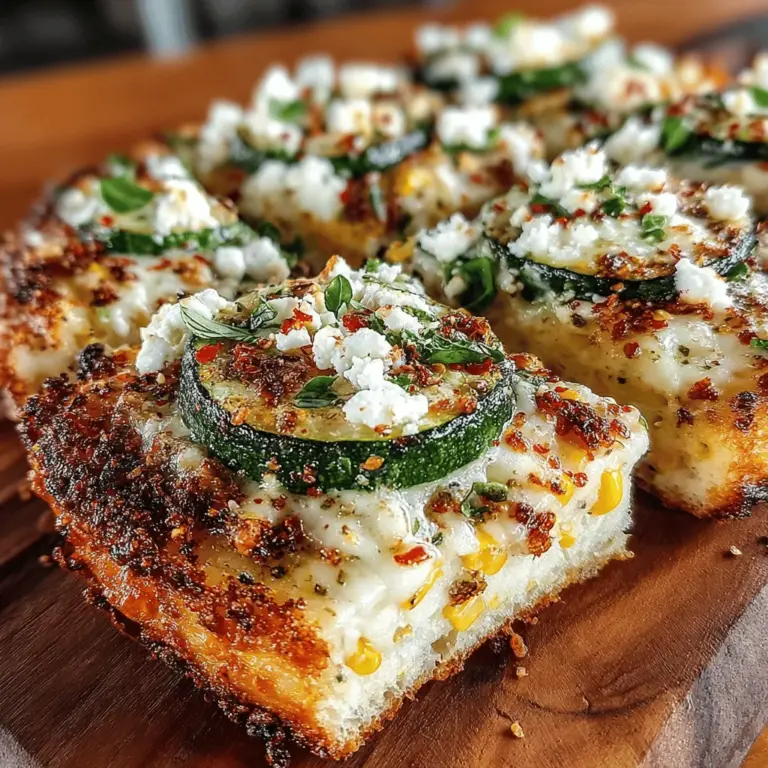Zucchini & Corn Pizza: A Delightful Twist on Traditional Pizza
In the ever-evolving culinary landscape, seasonal ingredients play a pivotal role in enhancing the flavor and appeal of our meals. One dish that beautifully embodies this philosophy is Zucchini & Corn Pizza. This recipe presents a delightful twist on the classic pizza experience, merging the freshness of garden vegetables with the savory richness of cheese. The result is a dish that is not only visually stunning but also incredibly satisfying, making it ideal for a quick weeknight dinner or a festive gathering with friends. In this article, we will explore the preparation process, highlight the benefits of the ingredients, and provide tips for customizing this versatile pizza to suit your taste.
Understanding the Key Ingredients
Exploring Zucchini and Corn
At the heart of Zucchini & Corn Pizza are two key ingredients: zucchini and corn.
Nutritional Benefits of Zucchini
Zucchini, a summer squash, is a nutritional powerhouse. It is low in calories yet high in essential vitamins and minerals, making it an excellent choice for those aiming to maintain a healthy diet. A single cup of sliced zucchini contains about 19 calories, providing a good source of vitamin C, potassium, and antioxidants. The high water content of zucchini makes it a hydrating food, while its fiber contributes to digestive health. Its mild flavor allows it to absorb the tastes of other ingredients beautifully, adding a subtle earthiness to any dish.
The Sweetness of Corn: Fresh vs. Frozen
Corn, with its naturally sweet profile, serves as the perfect counterbalance to zucchini’s mildness. When selecting corn for your pizza, you have the option of using fresh corn on the cob or frozen corn kernels. Fresh corn, when in season, offers a sweet crunch that is hard to beat. However, frozen corn is a convenient alternative that retains much of its flavor and texture, making it a reliable choice year-round. The sweetness of corn complements zucchini and adds a delightful burst of flavor, elevating the overall taste of the pizza.
Flavor Profiles and How They Complement Each Other
Together, zucchini and corn create a harmonious blend of flavors. The soft, slightly nutty taste of zucchini pairs beautifully with the sweet, crisp notes of corn. This combination not only enhances the flavor profile of the pizza but also adds visual appeal with a vibrant mix of colors. The addition of herbs and spices can further elevate this duo, creating a fresh and inviting pizza experience.
The Role of Cheese in Pizza
No pizza is complete without cheese, and in this Zucchini & Corn Pizza, the choice of cheese plays a critical role in achieving the desired flavor and texture.
Different Types of Cheese Used in This Recipe
For this recipe, we recommend a combination of mozzarella, feta, and Parmesan cheese. Mozzarella is the classic pizza cheese known for its excellent melting qualities and mild flavor. Feta adds a tangy twist, offering a contrast to the sweetness of the corn and the earthiness of the zucchini. Parmesan, with its nutty and savory notes, provides depth and richness that rounds out the flavor profile.
The Melting Point and Flavor Contribution of Mozzarella, Feta, and Parmesan
Each type of cheese brings unique characteristics to the pizza. Mozzarella melts beautifully, creating that signature gooey texture that pizza lovers crave. Feta, on the other hand, retains its shape when heated, adding bursts of flavor without becoming overly gooey. Parmesan, when grated and sprinkled on top, forms a crispy, golden crust in the oven, enhancing both the flavor and texture of the finished pizza.
How Cheese Enhances the Overall Texture and Taste
The combination of these cheeses not only contributes to a delightful taste but also creates a variety of textures. The creaminess of melted mozzarella, the crumbly nature of feta, and the crispy finish of Parmesan come together to create an indulgent eating experience.
Preparation Steps for Zucchini & Corn Pizza
The preparation of Zucchini & Corn Pizza is straightforward and can be broken down into a few essential steps. By following these guidelines, you can ensure that your pizza turns out deliciously every time.
Preheating the Oven for Optimal Cooking
One of the first steps in preparing your pizza is preheating the oven.
Importance of a Hot Oven
A hot oven is crucial for achieving a perfectly cooked pizza. The high temperature helps to crisp the crust while ensuring that the cheese melts evenly and the vegetables cook through without becoming soggy. Ideally, you should preheat your oven to at least 475°F (245°C) for optimal results.
Benefits of Using a Pizza Stone or Baking Sheet
For the best cooking results, consider using a pizza stone or a baking sheet. A pizza stone retains heat exceptionally well, allowing for a crispy crust reminiscent of a traditional pizzeria. If you don’t have a pizza stone, a baking sheet turned upside down can also work well, providing a flat surface that helps distribute heat evenly.
Sautéing the Vegetables
Next, you’ll want to prepare the zucchini and corn by sautéing them.
Techniques for Achieving the Perfect Sauté
To achieve the perfect sauté, start by slicing the zucchini into thin rounds to ensure even cooking. Heat a drizzle of olive oil in a skillet over medium heat. Once the oil is hot, add the zucchini and sauté for about 3-4 minutes until it begins to soften. Add the corn—if using fresh corn, be sure to cut it off the cob before adding it to the pan. If using frozen corn, there’s no need for thawing; simply toss it in and cook until heated through.
Balancing Flavors with Garlic and Spices
For added flavor, consider incorporating minced garlic and a pinch of red pepper flakes while sautéing the vegetables. Garlic adds an aromatic element, while red pepper flakes introduce a touch of heat, balancing the sweetness of the corn. Season the mixture with salt and pepper to taste.
Tips for Maintaining the Texture of Zucchini
To maintain the texture of the zucchini, avoid overcooking it. You want the zucchini to retain some of its firmness, as it will continue to cook in the oven once assembled on the pizza. The goal is to achieve a tender yet slightly crisp texture that complements the other ingredients.
Rolling Out the Dough
Once your vegetables are sautéed and your oven is preheated, it’s time to roll out the dough.
Differences Between Store-Bought and Homemade Pizza Dough
You can choose to use store-bought pizza dough for convenience or make your own from scratch for a more personalized touch. Store-bought dough can save time and effort, while homemade dough allows for customization in terms of flavor and thickness. If you opt for homemade, make sure to prepare it in advance, as it requires time to rise.
Tips for Achieving the Desired Thickness and Shape
When rolling out your dough, aim for a thickness of about 1/4 inch for a crispy crust. Use a floured surface to prevent sticking, and don’t be afraid to stretch the dough with your hands for an artisanal look. You can shape it into a round or rectangular form, depending on your preference and the size of your baking surface.
The Importance of Using Parchment Paper for Easy Transfer
To make the transfer of the assembled pizza to the oven easier, consider placing your rolled-out dough on a piece of parchment paper. This allows you to slide the pizza directly onto your baking stone or sheet without the risk of tearing the dough.
Assembling the Pizza
With all your components ready, it’s time to assemble your Zucchini & Corn Pizza.
Start by spreading a layer of tomato sauce or olive oil over the dough, leaving a small border for the crust. Next, evenly distribute the sautéed zucchini and corn mixture across the surface, followed by a generous sprinkling of mozzarella, feta, and Parmesan cheese. Feel free to add fresh herbs like basil or oregano for an aromatic finish.
As you prepare to bake, ensure that your oven is at the right temperature, and have your stone or baking sheet ready. This pizza is not only a celebration of fresh ingredients but also a testament to how simple steps can lead to a gourmet meal, bringing the essence of homemade cooking into your kitchen.
Stay tuned as we continue to explore more about this delightful pizza recipe, including baking tips, variations, and serving suggestions.

Layering Ingredients for Optimal Flavor Distribution
To achieve a pizza that is bursting with flavor, the order in which you layer your ingredients is crucial. Start with a generous spread of your chosen sauce—whether it’s a classic tomato sauce, pesto, or a simple olive oil base. This not only adds a rich flavor but also helps keep the crust from getting soggy.
Next, sprinkle a layer of shredded cheese. Mozzarella is the classic choice, but feel free to mix in some sharp cheddar or a sprinkle of parmesan for an extra punch. The cheese helps to bind the toppings and create a deliciously gooey texture.
Now, it’s time for the star ingredients: the zucchini and corn. Slice the zucchini thinly to ensure it cooks evenly and lays flat on the pizza. Spread the zucchini slices evenly across the cheese, followed by a scattering of fresh or frozen corn kernels. If using frozen corn, there’s no need to thaw it; just toss it directly onto the cheese.
Finally, add any additional toppings you desire, such as sliced bell peppers, red onions, or even a sprinkle of red pepper flakes for heat. A final light dusting of cheese on top can create a lovely golden crust.
Tips for Preventing Sogginess in the Crust
One of the most common issues when making homemade pizza is sogginess in the crust. Here are some tips to prevent that from happening:
1. Pre-bake the crust: Before adding your toppings, bake the crust for about 5-7 minutes. This helps to set the foundation and will prevent excessive moisture from soaking through.
2. Sauté vegetables: If you’re using fresh zucchini, consider sautéing it lightly before adding it to the pizza. This reduces moisture content and intensifies the flavor.
3. Use a pizza stone: If you have one, a preheated pizza stone can absorb moisture and help achieve a crispy crust. Place it in the oven while it preheats for the best results.
4. Avoid excess sauce: While it’s tempting to slather on lots of sauce, too much can lead to a soggy crust. A thin, even layer is sufficient.
5. Choose the right cheese: Some cheeses release more moisture than others. Opt for low-moisture mozzarella or add your fresh mozzarella towards the end of the baking process.
Baking the Perfect Pizza
Understanding Baking Times and Temperatures
The ideal baking temperature for pizza is typically between 475°F to 500°F (245°C to 260°C). This high heat ensures a crispy crust and well-cooked toppings. If you have a pizza stone, place it in the oven while it preheats to achieve the best results.
The Science Behind Achieving a Golden Crust
A perfectly baked pizza should have a golden brown crust that is both crispy and chewy. The Maillard reaction, which occurs between 300°F to 500°F (150°C to 260°C), is responsible for the browning of the crust. This is why high temperatures are essential.
How to Know When the Pizza is Done
To check if your pizza is ready, look for visual cues: the cheese should be bubbly and slightly browned, and the crust should be a rich golden color. You can also gently lift the pizza with a spatula to check the underside—if it’s golden brown, you’re good to go.
Techniques to Avoid Overcooking or Undercooking
To avoid the pitfalls of overcooking or undercooking, here are a few techniques:
– Rotate the pizza: Halfway through baking, rotate the pizza 180 degrees. This ensures even cooking, especially in home ovens that may have hot spots.
– Use a timer: Set a timer for 10 minutes and check the pizza; continue baking in 2-minute increments until it reaches the desired doneness.
– Invest in an oven thermometer: Home oven temperatures can often be inaccurate. An oven thermometer can help you ensure that you’re baking at the right temperature.
Serving Suggestions and Pairings
Garnishing Your Zucchini & Corn Pizza
Once your pizza is baked to perfection, garnishing is the final touch that elevates the dish. Fresh basil is a fantastic addition. It adds a burst of flavor and freshness. Simply tear the leaves and sprinkle them on the pizza right after it comes out of the oven to preserve their vibrant color and aroma.
Other garnishes that can enhance your pizza include:
– Arugula: A handful of fresh arugula adds a peppery contrast to the sweetness of the corn and zucchini.
– Balsamic glaze: A drizzle of balsamic reduction adds a sweet tang that complements the flavors beautifully.
– Crushed red pepper flakes: For those who enjoy a bit of heat, sprinkle some red pepper flakes before serving.
Suggested Side Dishes
To create a well-rounded meal, consider pairing your Zucchini & Corn Pizza with complementary side dishes:
– Simple Green Salad: A light salad with mixed greens, cherry tomatoes, cucumber, and a lemon vinaigrette can balance the richness of the pizza.
– Garlic Bread: A classic side that pairs beautifully with pizza, garlic bread adds a comforting touch to your meal.
– Roasted Vegetables: Seasonal roasted vegetables can enhance the meal’s overall flavor and provide additional nutrients.
Beverage Pairings
Choosing the right beverage can elevate your dining experience. Here are some beverage suggestions that work well with Zucchini & Corn Pizza:
– Light Beer: A crisp lager or a pale ale can complement the flavors without overpowering them.
– White Wine: A chilled Sauvignon Blanc or Pinot Grigio pairs well, offering a refreshing contrast to the pizza.
– Sparkling Water: For a non-alcoholic option, sparkling water with a slice of lemon can cleanse the palate.
The Health Benefits of Homemade Pizza
Comparing Homemade vs. Store-Bought
Making pizza at home comes with numerous advantages. Firstly, you have full control over the ingredients, allowing you to choose fresh, high-quality items. This means you can avoid preservatives and other unwanted additives often found in store-bought options.
Additionally, homemade pizza allows you to customize portion sizes, making it easier to manage calorie intake while still enjoying a delicious meal.
Nutritional Insights
Zucchini and corn are not only tasty but also packed with nutrients. Zucchini is low in calories and high in water content, making it an excellent choice for hydration and weight management. It’s also a good source of vitamin C and antioxidants.
Corn, on the other hand, provides fiber, which aids digestion, and contains beneficial nutrients like B vitamins and magnesium. Together, these vegetables create a balanced topping that enhances the nutritional profile of your pizza.
By opting for vegetable-rich toppings like zucchini and corn, you can make pizza a healthier option. Additionally, using whole grain crusts or alternative flours can further increase the fiber content, making this dish a wholesome choice for any meal.
Conclusion
Zucchini & Corn Pizza is more than just a meal; it’s a celebration of fresh, wholesome ingredients. This recipe captures the essence of seasonal cooking while providing a satisfying and nutritious option for pizza lovers. By preparing your pizza at home, you can customize every aspect to suit your taste, making it an enjoyable culinary adventure. Whether you serve it for a casual family dinner or as a main attraction at a gathering, this pizza is sure to impress with its vibrant flavors and delightful textures. Enjoy the process of creating this delicious dish, and relish every bite of your homemade masterpiece.


